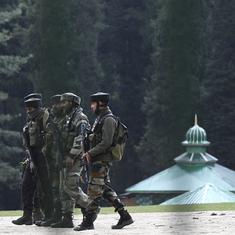Last week, heavy rains caused the river Jhelum to spill its banks, submerging large swathes of the state. Tens of thousands of people were trapped on the upper floors of their homes. At least 277 people have died in the flood so far.
The government has deployed 30 small water pumps and two heavy duty pumps of the Oil and Natural Gas Corporation to dry out the most severely affected areas. Twenty fire-tenders of the Fire and Emergency Services Department have also been pressed into service to flush out the water. However, locals say the water level has decreased by only two inches in 24 hours. As a result, locals have cut the river's embankments in some places to drain out the water into a flood channel.
Still submerged
The High Court, Secretariat, the Lal Chowk central area, Maisuma, Rajbagh, Jawahar Nagar, Padshahi Bagh and a few other areas remain submerged under between three feet and ten feet of water.
The responsibility of dewatering has fallen to the irrigation department. Channels will be cut into the river Jhelum so that the water flows back into it. This process will take around three days, said Rinzin Jora, the minister for urban development and urban local bodies.
The National Conference government, which had been accused of collapsing under the stress of the crisis, has divided Srinagar into three zones in an attempt to ensure that the process of pumping water out of the streets is supervised more efficiently. Each zone is headed by senior officers of the Housing and Urban Development department.
Chief Minister Omar Abdullah said that as a result of Kashmir's unique location, water takes a very long time to collect in the Valley ‒ but when it does, it takes a long time to flow out. “There are areas in Kashmir which have been under water for 10-12 days and in such conditions, threat of diseases is high, ” NDTV reported him saying.
In place where the water has receded, the roads and streets are stinking, as heaps of garbage and animal carcasses have piled up, causing fears of epidemics. Though Srinagar Municipal Corporation workers were seen attempting to clear the trash in some areas, as many as 300 carcasses of cows lie in streets.
An opportunity
Abdullah said that Kashmir should take the opportunity to learn from this disaster, rebuilding "in a planned manner”. Yet no rebuilding or rehabilitation plan seems to be visible. When the National Conference was campaigning during the last election, it promised voters “sadak, bijli and paani" ‒ roads, electrity and water. Now there is water everywhere, but the roads have been swept away and the power has collapsed.
Abrar Ali, a Kashmiri entrepreneur, said that the state government had crumbled in the face of the devastation. “It is very unfortunate that the government has failed completely when it comes to dewatering the roads, sanitation and health-related concerns,” said the 26-year-old resident of Dalgate, which is still submerged.
This, he said, had forced ordinary citizens to fend for themselves. “People have started the sanitation and dewatering process on individual and local committee levels,” Ali said.










